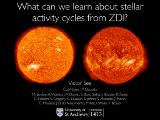Files in this item
What can we learn about stellar activity cycles from ZDI?
Item metadata
| dc.contributor.author | See, Victor | |
| dc.contributor.author | Jardine, M. | |
| dc.contributor.author | Vidotto, A. | |
| dc.contributor.author | Donati, J.-F. | |
| dc.contributor.author | Boro Saikia, S. | |
| dc.contributor.author | Bouvier, J. | |
| dc.contributor.author | Fares, R. | |
| dc.contributor.author | Folsom, C. | |
| dc.contributor.author | Gregory, S. | |
| dc.contributor.author | Hussain, G. | |
| dc.contributor.author | Jeffers, S. | |
| dc.contributor.author | Marsden, S. | |
| dc.contributor.author | Morin, J. | |
| dc.contributor.author | Moutou, C. | |
| dc.contributor.author | do Nascimento, J. D. | |
| dc.contributor.author | Petit, P. | |
| dc.contributor.author | Waite, I. | |
| dc.contributor.author | +BCool Collaboration | |
| dc.date.accessioned | 2017-03-03T10:30:14Z | |
| dc.date.available | 2017-03-03T10:30:14Z | |
| dc.date.issued | 2016-08-01 | |
| dc.identifier.citation | See , V , Jardine , M , Vidotto , A , Donati , J-F , Boro Saikia , S , Bouvier , J , Fares , R , Folsom , C , Gregory , S , Hussain , G , Jeffers , S , Marsden , S , Morin , J , Moutou , C , do Nascimento , J D , Petit , P , Waite , I & +BCool Collaboration 2016 , ' What can we learn about stellar activity cycles from ZDI? ' , Paper presented at 19th Cambridge Workshop on Cool Stars, Stellar Systems and the Sun (CS19) , Uppsala , Sweden , 6/06/16 - 10/06/16 . https://doi.org/10.5281/zenodo.156542 | en |
| dc.identifier.citation | workshop | en |
| dc.identifier.other | PURE: 249288270 | |
| dc.identifier.other | PURE UUID: cd428981-441e-4272-acf9-a8a44ef8b0a5 | |
| dc.identifier.other | BibCode: 2016csss.confE..25S | |
| dc.identifier.other | ORCID: /0000-0002-1466-5236/work/57821810 | |
| dc.identifier.uri | https://hdl.handle.net/10023/10397 | |
| dc.description.abstract | It is known that activity cycles, similar to the 11 year cycle of the Sun, can exist on other stars. Previous work suggests that stars may lie on two branches in a cycle period vs rotation period diagram though there is no definitive explanation for why this should be the case.Fundamentally, activity cycles occur as a result of the underlying dynamo. Indeed, a great deal has been learnt about the Sun's activity cycle by studying how its magnetic field evolves over each activity cycle. In the same way, we should be able to learn about the activity cycles of other stars by studying their magnetic field properties. In this talk, I will present new insights into stellar activity cycles by analysing the magnetic maps of stars that are known to present activity cycles. I will show that stars along each of the branches appear to have different magnetic field topologies. | |
| dc.language.iso | eng | |
| dc.rights | Copyright the Author(s) 2016. Made available under a Creative Commons Attribution 4.0 license https://creativecommons.org/licenses/by/4.0/ | en |
| dc.subject | QB Astronomy | en |
| dc.subject | QC Physics | en |
| dc.subject.lcc | QB | en |
| dc.subject.lcc | QC | en |
| dc.title | What can we learn about stellar activity cycles from ZDI? | en |
| dc.type | Conference paper | en |
| dc.contributor.sponsor | Science & Technology Facilities Council | en |
| dc.description.version | Publisher PDF | en |
| dc.contributor.institution | University of St Andrews. School of Physics and Astronomy | en |
| dc.identifier.doi | https://doi.org/10.5281/zenodo.156542 | |
| dc.description.status | Peer reviewed | en |
| dc.identifier.url | http://adsabs.harvard.edu/abs/2016csss.confE..25S | en |
| dc.identifier.grantnumber | ST/M001296/1 | en |
This item appears in the following Collection(s)
Items in the St Andrews Research Repository are protected by copyright, with all rights reserved, unless otherwise indicated.

